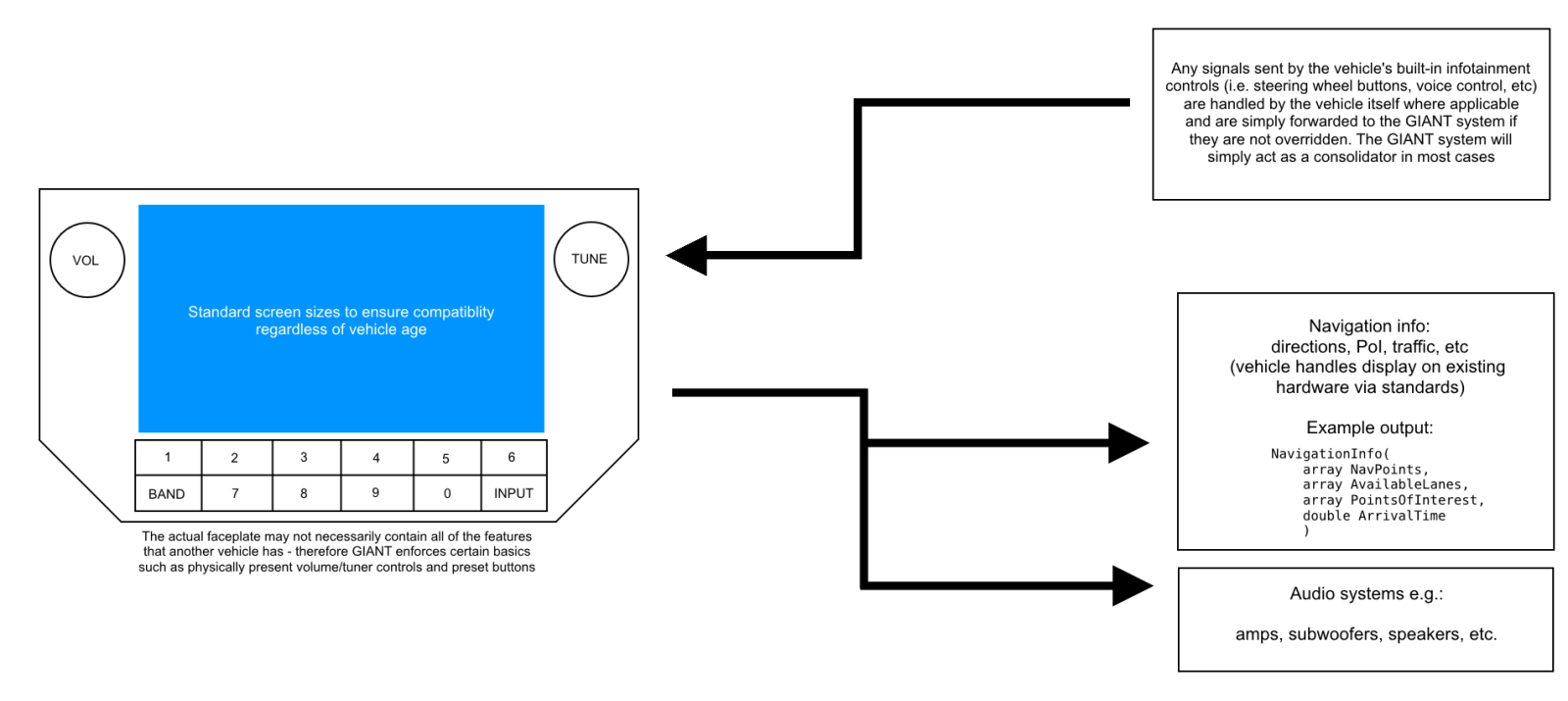
Modern automotive infotainment systems are awful. Sure, the software might be great, and it might be the best thing ever designed - but as we all know, what we consider great now will become obsolete within 5 to 10 years. We’ve seen that far too many times to count. It’s why aftermarket radio units were made that support extra outputs and are generally better in terms of functionality than the units they were designed to replace.
So why not apply that to the infotainment systems in automobiles?
Enter my grand idea - the General Infotainment And Navigation Terminal, or GIANT. (Sorry, I couldn’t resist making a backronym.)
The first thing GIANT would do is to set standards for connectors/ports and how they link up into the vehicle’s system. Each connector would be designed around a specific purpose (ideally with as much future-proofing as possible,) and allow for expansion with such thing as aftermarket amps and woofers. The major thing to do would be to integrate it such that the main unit can send and receive information related to telephone calls, navigation data, etc. that smoothly integrates with the vehicle’s existing system. For example, a hypothetical vehicle integrates a “next turn” system into its gauge cluster display. This display should be capable of accepting information from any number of infotainment systems, including factory systems, using a standard protocol that contains all of the necessary information - and ideally the protocol will be forwards- and backwards-compatible for eternity, meaning that the system will only read the information it needs and discard anything else. The other thing would be to make buttons compatible with a generic standard that allows the OOBE (out of box experience) to be as smooth as possible with as many systems as possible, but allowing advanced users to rebind and/or outright disable certain buttons should the system send a signal that the GIANT system doesn’t entirely understand (either because the vehicle itself is too old or too new for the system itself to know what’s going on.)
A standard array of connectors might include the following:
- Vehicle-to-system data bus (think of something like a motherboard’s 24-pin connector) - handles reading vehicle speed for the all important “we’re not liable if you crash”/speed-controlled volume, dimmer switch, navigation data, etc.
- Power connector
- Standard audio connector - can feature extra connectors for vehicles that support this, think of it like a modular power supply that lets you plug in and remove cables you’re not using.
GIANT would heavily discourage the integration of functions such as HVAC controls into the system without physical backups in the event a GIANT system fails. Any system exclusively controlled through the touch screen should be non-critical, such as music, navigation or seat massaging, and should automatically default (in the event of a failure state) to being off.
The next thing GIANT would do would be to set a standard for infotainment system form factors. These form factors would be based around current infotainment system form factors that are the most reasonable, such as the Mazda tack-on infotainment system format, and the Toyota image used above. It isn’t entirely necessary to stick with a GIANT form factor, allowing Volvo-like integrated systems to exist, however a standard form factor would allow third parties to make their own GIANT-compatible systems for aftermarket installation. A manufacturer like Kenwood or Pioneer could make their own GIANT unit that is a drop-in replacement for, say, the 180mm “widescreen” form factor, or one for the 130mm “square” form factor. All that a GIANT unit would handle is being the display/touch interface/GPS controller/etc for the vehicle - it would not require replacing a faceplate or fabricobbling a new one. Space would be made for water-tight gaskets and systems for something in the future where we can just power wash an interior because it’s all made of rubber or something like that.
Here’s a really crappy mockup that I made that hopefully explains a little bit of it.

I’ve run out of ideas for now - but I’ve been thinking about how a system like this could work if time was spent to create a universal system that was cheap and easy to implement for an automaker, one so cheap that spending the amount of time they do to make an in-house system would be pointless when they could just contract out to a maker of GIANT systems to have their own corporate skins and add-ons attached to a GIANT device, much like how an Android device can have a corporate theme applied to it.
I think way too much about these things.